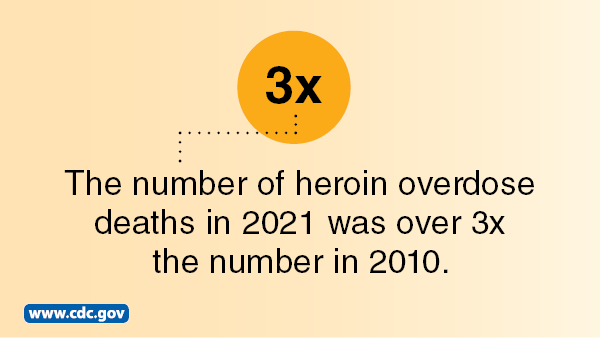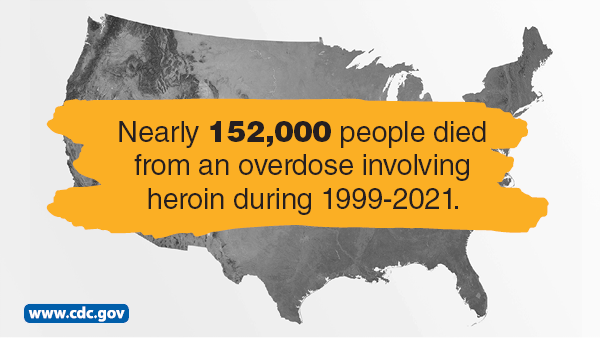Heroin

Over 11% of all opioid overdose deaths in 2021 involved heroin1. Not only are people using heroin, but they are also using multiple other substances, including cocaine and prescription opioids. Nearly all people who use heroin also use at least one other drug2.
However, from 2020 to 2021, the heroin overdose death rate decreased by nearly 32%1. Factors that may contribute to the decrease in heroin-involved deaths include fewer people initiating heroin use3, shifts from a heroin-based market to a fentanyl-based market4, increased treatment provision for people using heroin, and expansion of naloxone access5.
Learn more about Heroin Data.
How is heroin harmful?

- Heroin is an illegal, highly addictive opioid drug.
- A heroin overdose can cause slow and shallow breathing, coma, and death.
- People often use heroin along with other drugs or alcohol. This practice is especially dangerous because it increases the risk of overdose2.
- Heroin is typically injected but is also smoked and snorted. When people inject heroin, they are at risk of serious, long-term viral infections such as HIV, Hepatitis C, and Hepatitis B, as well as bacterial infections of the skin, bloodstream, and heart6.
Related Pages
- Trends and Geographic Patterns in Drug and Synthetic Opioid Overdose Deaths 2013–2019 — United States (MMWR)
- CDC MMWR: Demographic and Substance Use Trends Among Heroin Users — United States, 2002–2013
- Vital Signs: Heroin Epidemic – More People at Risk, Multiple Drugs Abused
- Press Release: Heroin overdose deaths increased in many states through 2012
- NCHS Data Brief: Drug Overdose Deaths in the United States, 1999–2020
- Wide-ranging online data for epidemiologic research (WONDER). Atlanta, GA: CDC, National Center for Health Statistics; 2022. Available at http://wonder.cdc.gov.
- Jones CM, Logan J, Gladden RM, Bohm MK. Vital Signs: Demographic and Substance Use Trends Among Heroin Users — United States, 2002–2013. MMWR Morb Mortal Wkly Rep 2015; 64(26):719-725.
- 2019 Annual Surveillance Report of Drug-Related Risks and Outcomes — United States Surveillance Special Report Centers for Disease Control and Prevention: U.S. Department of Health and Human Services. Published November 1, 2019.
- Department of Justice, Drug Enforcement Administration. 2019 National Drug Threat Assessment [PDF]Washington, DC: U.S. Department of Justice, Drug Enforcement Administration; 2019.
- Guy GP, Jr., Haegerich TM, Evans ME, Losby JL, Young R, Jones CM. Vital Signs: Pharmacy-Based Naloxone Dispensing – United States, 2012-2018. MMWR Morb Mortal Wkly Rep. 2019 Aug 9;68(31):679-86.
- Substance Abuse and Mental Health Services Administration. Alcohol, Tobacco, and Other Drugs: Opioids. http://www.samhsa.gov/atod/opioids.
- Hedegaard H, Miniño AM, Spencer MR, Warner M. Drug Overdose Deaths in the United States, 1999–2020 [PDF]. National Center for Health Statistics, December 2021.
- Spencer MR, Miniño AM, Warner M. Drug overdose deaths in the United States, 2001–2021. NCHS Data Brief, no 457. Hyattsville, MD: National Center for Health Statistics. 2022. DOI: https://dx.doi.org/10.15620/cdc:122556
